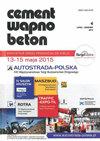Residue after the extraction of potassium and chlorine from by-pass dust as a new raw material for the synthesis of low-emission Portland clinker
IF 0.6
4区 工程技术
Q4 CONSTRUCTION & BUILDING TECHNOLOGY
引用次数: 0
Abstract
By-pass dusts are waste products formed during the production of Portland clinker. Due to the high amounts of chlorine in by-pass dust, they cannot be reused in cement production. Mineral fertilizer producers have the technology to recover potassium from by-pass dust, during which unwanted chlorine is simultaneously extracted. Due to the high content of non-carbonated CaO in the residue after extracting potassium and chlorine from by-pass dust, this material can be a very valuable ingredient in the production of Portland clinker. This paper aims to present the possibility of producing low-emission Portland clinker using the residue after extracting potassium and chlorine from by-pass dust. Using the maximum amount of extraction residue in the raw material sets from which Portland clinker is produced reduced emissions by 407.6 kg CO2 per Mg of Portland clinker, compared to Portland clinker produced from natural carbonate raw materials. Additionally, cements made from clinkers calcined with extraction residue showed better strength increases after 2, 7, 28, and 90 days of curing compared to reference cement made from Portland clinker calcined with natural carbonate raw materials.从旁通粉尘中提取钾、氯后的残渣作为合成低排放硅酸盐熟料的新原料
旁通粉尘是硅酸盐熟料生产过程中产生的废弃物。由于旁路粉尘中的氯含量很高,它们不能在水泥生产中重复使用。矿物肥料生产商拥有从旁通粉尘中回收钾的技术,在此过程中,不需要的氯被同时提取出来。由于从旁通粉尘中提取钾、氯后的废渣中非碳酸化CaO含量高,因此该原料可作为生产硅酸盐熟料的重要原料。介绍了利用旁通粉尘提钾、提氯后的废渣生产低排放硅酸盐熟料的可能性。与使用天然碳酸盐原料生产的波特兰熟料相比,在生产波特兰熟料的原料组中使用最大数量的萃取渣,每毫克波特兰熟料可减少407.6千克二氧化碳的排放量。此外,用萃取渣煅烧的熟料制成的水泥在养护2、7、28和90天后,与用天然碳酸盐原料煅烧的硅酸盐熟料制成的对照水泥相比,强度增加得更好。
本文章由计算机程序翻译,如有差异,请以英文原文为准。
求助全文
约1分钟内获得全文
求助全文
来源期刊

Cement Wapno Beton
CONSTRUCTION & BUILDING TECHNOLOGY-MATERIALS SCIENCE, COMPOSITES
CiteScore
1.30
自引率
28.60%
发文量
0
审稿时长
>12 weeks
期刊介绍:
The Publisher of the scientific bimonthly of international circulation, entitled "Cement-Wapno-Beton" ["Cement-Lime-Concrete"], is the Fundacja Cement, Wapno, Beton [Foundation Cement, Lime, Concrete]. The periodical is dedicated to the issues concerning mineral setting materials and concrete. It is concerned with the publication of academic and research works from the field of chemistry and technology of building setting materials and concrete
 求助内容:
求助内容: 应助结果提醒方式:
应助结果提醒方式:


